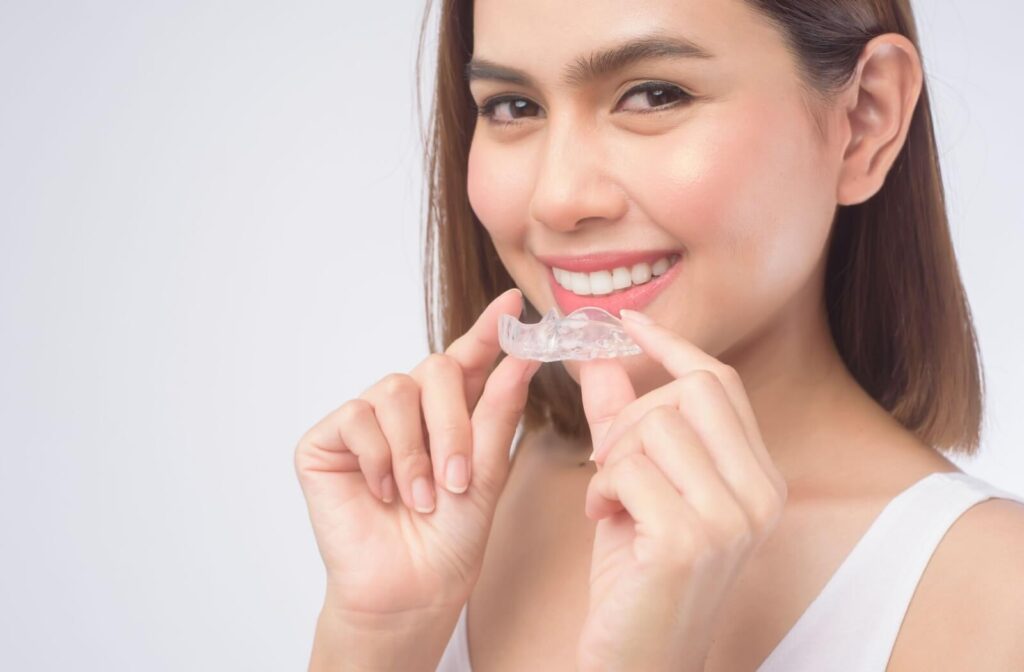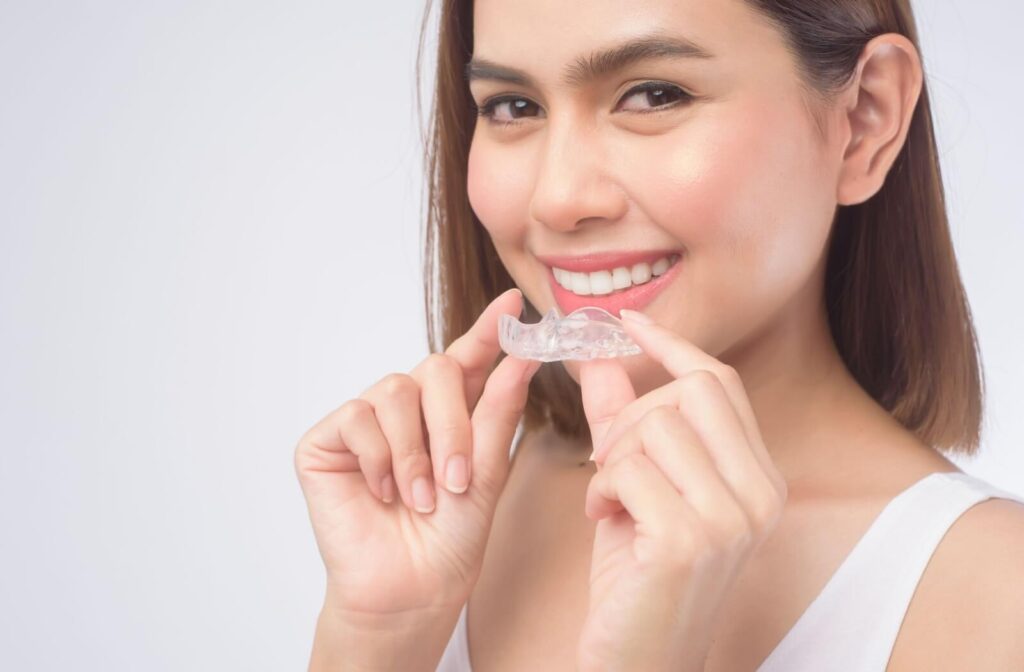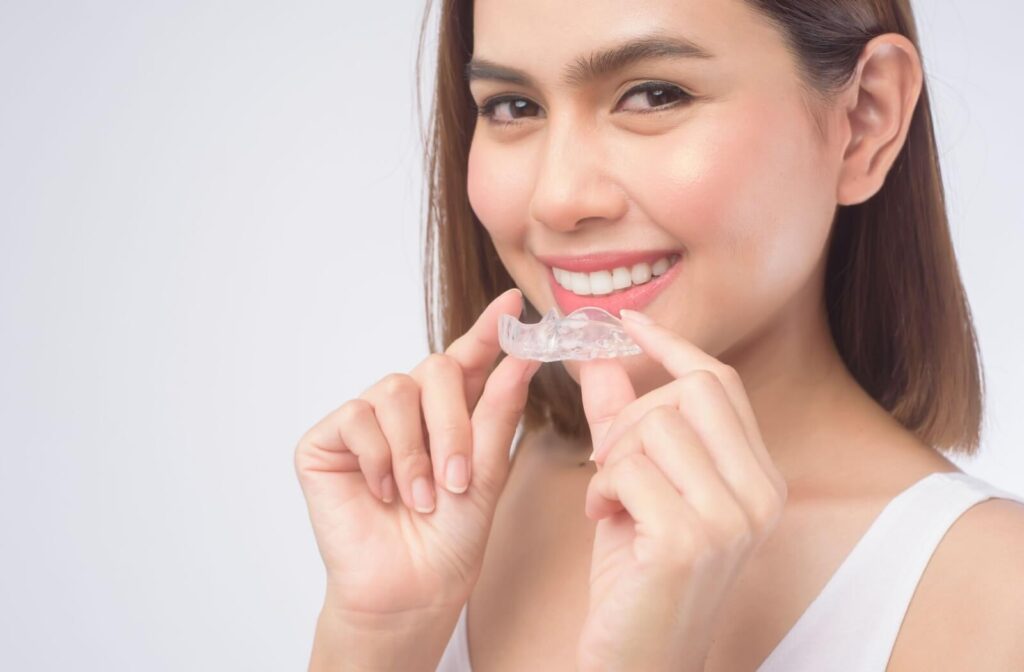
Is Invisalign Better Than Braces?

Invisalign, a type of clear aligner, has long been growing in popularity over traditional metal and ceramic braces due to their almost invisible look when worn and their ability to be removed for short amounts of time.
But is Invisalign the better option for you than traditional braces? It’s not all black and white since they both have advantages and disadvantages. We’ll discuss the pros and cons, share expert insights, and guide you on the path toward straighter teeth.
Understanding Invisalign & Braces
Braces
Traditional braces consist of metal or ceramic brackets attached to each tooth, connected by wires. These wires are periodically tightened to gradually shift teeth into the desired position. This tried-and-true method has been effective for decades, even for complex dental issues.
However, braces are quite noticeable with their visible wires and brackets. Regular visits to the orthodontist every 4 to 6 weeks are necessary for adjustments, which can be a time-consuming commitment.
Invisalign
Invisalign, on the other hand, uses clear plastic aligners that gently move teeth into position. Each aligner is custom-made and replaced every two weeks, providing a gradual shift. Unlike braces, Invisalign aligners are plastic, making them less visible, and you can remove them for eating, brushing, or special occasions. This makes them a comfortable and convenient choice for many.
Invisalign can effectively address various dental issues, such as some types of underbite, overbite, crossbite, open bite, gap teeth, and crowded teeth. While both options can be successful, the flexibility of removing Invisalign aligners makes them particularly appealing.
The Positives of Invisalign
Subtle Appearance
Invisalign aligners are often dubbed “invisible braces” due to their transparent material. This feature can be a huge relief for anyone self-conscious about having visible metal brackets. You can confidently go about your day without drawing attention to your dental treatment.
Removability
Unlike fixed braces, Invisalign aligners are removable. You can take them out for eating, brushing, or attending special events. This offers the advantage of better oral hygiene and the freedom to enjoy your favorite foods without restrictions. Just remember to wear them for at least 22 hours a day for effective results.
Comfort
Invisalign aligners are made from smooth plastic, eliminating the discomfort of metal wires and brackets poking at your mouth. They’re customized to fit your teeth snugly, ensuring increased comfort throughout the adjustment period.
Easy Brushing & Flossing
Brushing and flossing are a breeze with Invisalign. Since you can remove the aligners, you can clean your teeth as usual without navigating around wires and brackets. This helps you maintain your oral hygiene throughout your treatment.
The Drawbacks of Invisalign
Demands Discipline
Invisalign requires discipline and responsibility. You must remove and replace the aligners regularly, wearing them for at least 22 hours daily. Failing to do so can prolong treatment or lead to misaligned results. Consistency is key!
Requires More Frequent Brushing
With Invisalign, you’ll need to brush your teeth more often. The snug fit of the aligners creates an environment where bacteria can thrive if food particles are trapped. Brushing after eating or rinsing your mouth before reinserting the aligners is essential to prevent bad breath and tooth decay.
The Positives of Braces

Complex Corrections
Braces can tackle complex dental issues, from crooked teeth to severe overbites. While Invisalign can address rotated teeth and jaw problems, braces often provide more precise adjustments. They’re a preferred option for cases requiring extensive correction.
No Need for Removal
With braces, there is no need to consciously monitor wearing them as they are fixed to the teeth, unlike Invisalign, which requires you to keep track of wear time. This is beneficial for individuals who may struggle with the discipline required to consistently remember to wear their aligners, like teenagers and younger patients.
Financial Savings
In many cases, braces can be a more cost-effective solution than Invisalign. This is often a consideration for families or individuals on a tighter budget. Traditional braces do not require the replacement of aligners every couple of weeks, which can contribute to their overall lower cost. Also, insurance plans may cover a larger portion of traditional braces than Invisalign, reducing out-of-pocket expenses.
The Drawbacks of Braces
Discomfort
Braces are not without their drawbacks. The discomfort of pressure, soreness, and difficulty eating is common during the adjustment period. The treatment duration, often lasting anywhere from one to three years, requires plenty of patience. Metal bars may also press on the inside of the cheek, and braces can get in the way.
Food Limitations
Braces come with dietary restrictions. Foods like popcorn, nuts, sticky candies, and chewy treats are off-limits due to the risk of damaging or shifting braces. These limitations can be frustrating for those who enjoy a varied diet.
Making the Right Choice for Your Smile
Misaligned teeth can lead to oral hygiene challenges and potential dental issues. Invisalign offers a modern solution to address these concerns and improve long-term dental health.
Ultimately, the decision between Invisalign and traditional braces is a personal one. If you’re considering orthodontic treatment, contacting us at Orthodontic Smile Studio is a great first step. Our specialists can help determine which option suits your smile and lifestyle best.
DGS powered by SmileShop


